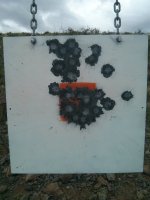Why are AR15s so difficult to shoot for the average shooter?
- By gopherslayer
- Semi-Automatic Rifles
- 96 Replies
Like has been said, fundamentals are big for ARs. I’m kind of a weirdo when it comes to ARs. I shoot a large frame better than a small. It seems to fit me better.
2 weekends ago I was shooting this crap and making 10/10 head shots at 310 yards with a suppressed Criterion pencil barrel and a 1-5 XTRII. It’s from the Sandy Hook days and isn’t as accurate as the same stuff I bought from 2017 that I have stashed away.

2 weekends ago I was shooting this crap and making 10/10 head shots at 310 yards with a suppressed Criterion pencil barrel and a 1-5 XTRII. It’s from the Sandy Hook days and isn’t as accurate as the same stuff I bought from 2017 that I have stashed away.





